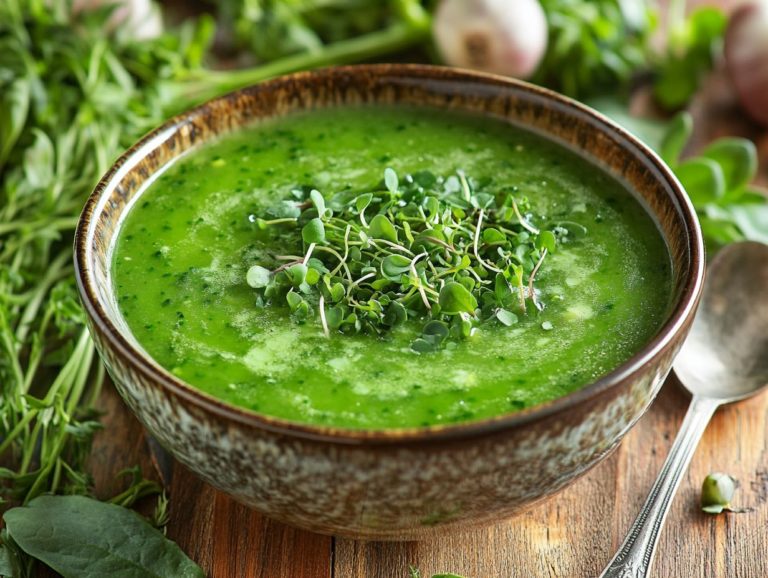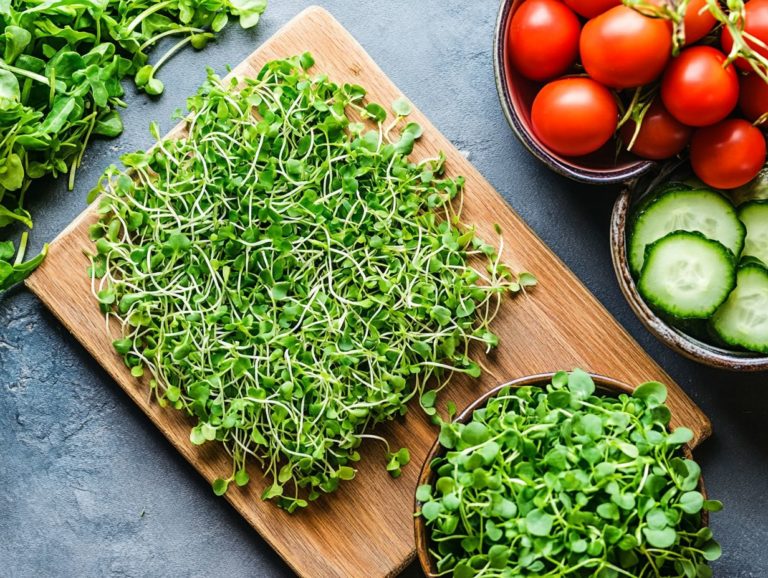100. Microgreens in Asian Cuisine: Fresh Recipe Ideas
Microgreens are those petite, nutrient-rich seedlings of vegetables and herbs that are packed with flavor and a variety of health benefits, making them the perfect solution for anyone looking to enhance their cooking at home.
Immerse yourself in the vibrant world of microgreens, especially their essential role in traditional recipes like Saessak Bibimbap (a traditional Korean rice dish) and other comforting dishes. Uncover the nutritional treasures that position these greens as powerhouses in your diet, while also exploring popular varieties that grace traditional dishes.
Let your creativity flow with innovative recipes that highlight their unique essence, including quick and easy meals that the whole family can enjoy.
Learn the art of growing your own microgreens at home and discover the best places to source them, especially during pandemic mode when fresh ingredients are hard to find. Dive in and elevate your culinary experience with these delightful greens, as they add vibrant colors and delicious flavors to any dish!
Contents
- Key Takeaways:
- Health Benefits of Microgreens
- Popular Microgreens Used in Asian Cuisine
- Incorporating Microgreens into Asian Dishes
- How to Grow Your Own Microgreens
- Where to Buy Microgreens
- Frequently Asked Questions
- What are microgreens and how are they used in Asian cuisine?
- What are some popular types of microgreens used in Asian cuisine?
- How can I incorporate microgreens into my Asian dishes?
- Are there any health benefits to using microgreens in Asian cuisine?
- Where can I purchase microgreens for my Asian recipes?
- Can I substitute microgreens for other herbs or greens in my Asian dishes?
Key Takeaways:
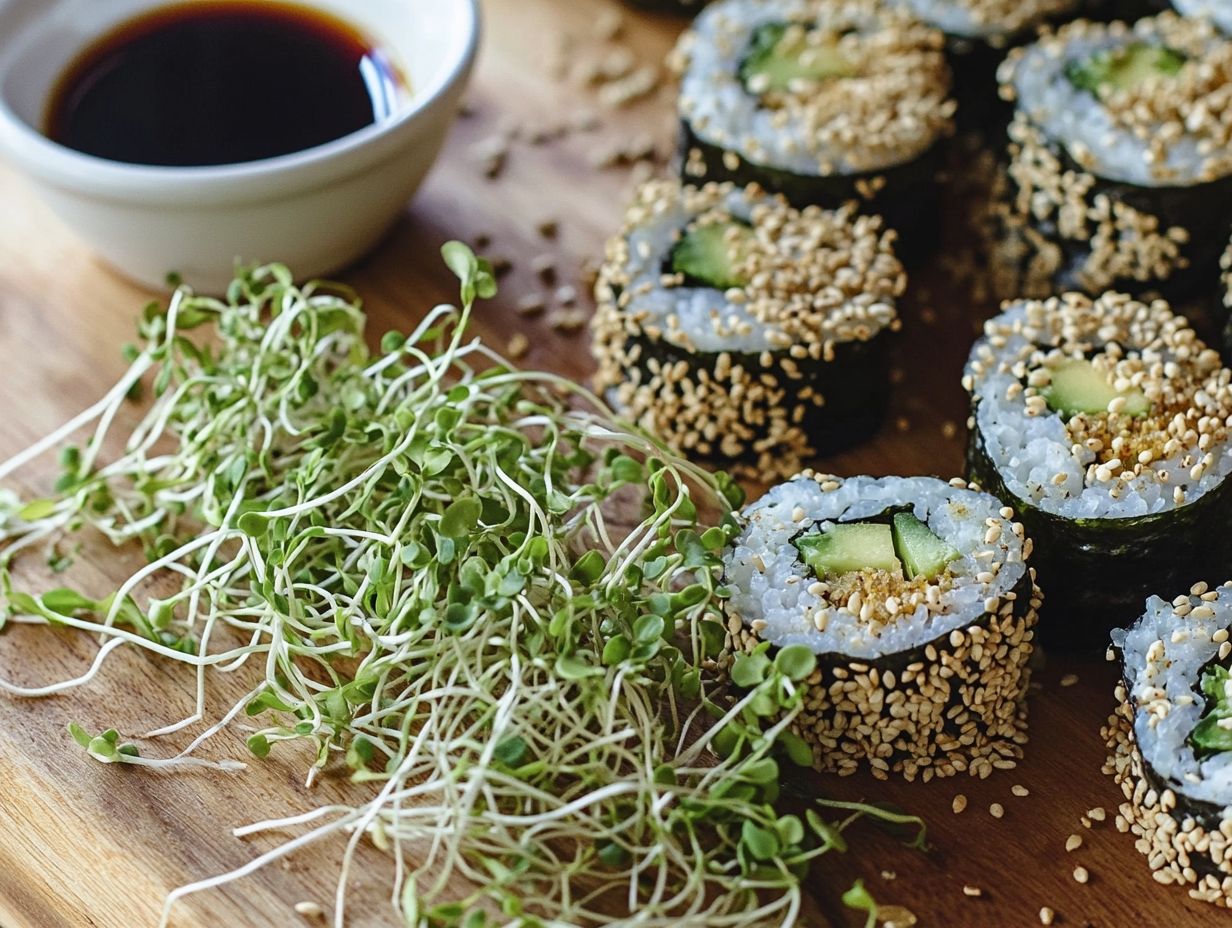
- Discover the benefits of incorporating microgreens into your Asian dishes, including their high nutritional value and potential health benefits, especially in meals like Korean rice bowls or delicious salads.
- Diversify your Asian cuisine by using a variety of colorful and flavorful microgreens, such as radish, mustard, and shiso.
- Learn how to easily grow your own microgreens at home with a step-by-step guide, along with time-saving tips for preparation, or explore different purchasing options for those who prefer to buy them.
What are Microgreens?
Microgreens are tiny edible plants that you can harvest just after the first leaves appear, and they burst with flavor and nutrition. They re perfect for enhancing dishes like Saessak Bibimbap or vibrant salads. With their variety of flavors and colors, these lively greens add a delightful touch to both traditional Korean cuisine and contemporary culinary creations, all while providing essential nutrients that support your healthy eating journey.
These miniature wonders can include varieties such as sunflower, radish, and basil, each cultivated for its rich taste profile and celebrated for its health benefits. Imagine how microgreens can elevate the sensory experience of your meals by introducing distinct flavors and textures, making your cooking not just about nutrition but also about vibrant flavors. It s no wonder they re a beloved choice among chefs looking to create visually stunning plates.
But it s not just about looks; these little greens are brimming with antioxidants, vitamins, and minerals, boosting both the flavor and nutritional value of your dishes. Including microgreens in recipes like Saessak Bibimbap not only enriches the aroma and visual appeal but also promotes a healthier lifestyle, inviting you to explore diverse ingredients for a balanced and nourishing diet.
Health Benefits of Microgreens
Microgreens offer amazing health benefits, brimming with vitamins, minerals, and antioxidants that play a crucial role in enhancing your overall wellness. Incorporating these healthy greens into your diet is essential for anyone committed to a healthy food regimen.
Not only do they elevate the nutritional profile of dishes like Korean rice bowls, but they also serve as flavorful toppings, allowing you to relish delicious recipes while placing your health front and center.
Nutritional Value and Potential Health Benefits
The nutritional value of microgreens is amazing. They often contain higher levels of vitamins and antioxidants than mature plants, making them essential for healthy dishes.
Using these nutrient-packed greens in your meals boosts both flavor and health. They can transform dishes from stir-fries to quick salads.
For example, broccoli microgreens are loaded with sulforaphane, a compound that may help fight cancer. Radish microgreens add a zesty kick and provide essential minerals like potassium and calcium.
Picture bright greens on your avocado toast for a nutritious breakfast. You can even blend them into smoothies for a refreshing detox drink.
Pea shoots, rich in vitamin C and iron, add a satisfying crunch to your dishes and boost immunity. Enjoying microgreens means you re not just savoring delightful flavors; you re also gaining amazing health benefits.
Popular Microgreens Used in Asian Cuisine
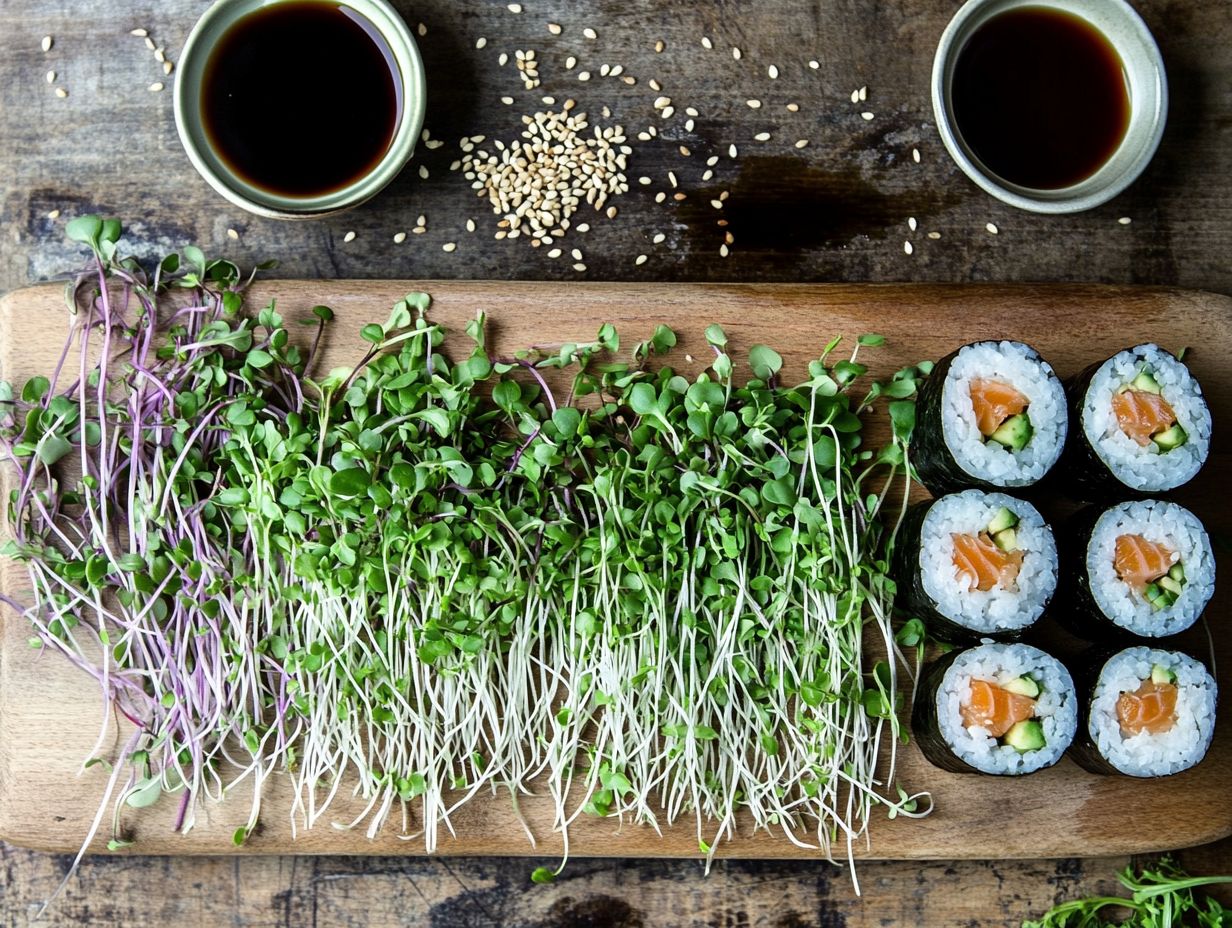
In Asian cuisine, various microgreens are celebrated for their unique tastes and bright colors. These tiny greens are key players in both traditional and modern dishes.
Picture fresh sprouts adding a peppery note to Saessak Bibimbap or flavorful herbs enhancing Korean pancakes. They don t just add nutrition; they elevate the entire eating experience.
Types and Flavors of Microgreens
Countless types of microgreens offer unique flavors, from sweet to peppery. These vibrant greens enrich your dishes with colors and textures.
Varieties like arugula, radish, and basil do more than just please the eye; they enhance the taste of your meals. They are a favorite among chefs and home cooks alike.
In the kitchen, these greens can elevate a wide range of recipes, especially in Asian cuisine. For instance, wasabi microgreens add a delightful kick to sushi.
Cilantro microgreens provide a fresh burst in spicy Thai curries, while sweet pea shoots make a perfect garnish for stir-fries or salads. With their versatility, incorporating them into meals enhances both visual appeal and flavor.
Incorporating Microgreens into Asian Dishes
Adding microgreens to Asian dishes boosts flavor and nutrition. This creates a balance that transforms everyday meals into extraordinary experiences.
You can top a Korean rice bowl or use them as a garnish for egg dishes or salads. These fresh greens introduce irresistible complexity and freshness! For more ideas, check out microgreen varieties and their culinary uses.
Creative Recipe Ideas
Creative recipe ideas featuring microgreens can truly elevate your culinary creations, transforming simple dishes into exceptional masterpieces that highlight their versatility, especially in Asian cuisine, while championing healthy eating habits. From quick stir-fries topped with a medley of flavors to intricate recipes like Saessak Bibimbap, these vibrant greens infuse both flair and nutrition into every dish you prepare.
Incorporating microgreens into your meals brings a delightful crunch and an explosion of flavor, enhancing everything from salads to tacos. Imagine a refreshing summer salad by tossing in a mix of pea shoots and arugula microgreens; you’ll not only add a burst of color but also vital nutrients. For more ideas, check out cooking with microgreen varieties: tips and tricks that elevate the entire experience.
When crafting a savory omelet, consider adding a handful of sunflower microgreens; they can intensify the dish’s flavor profile while boosting its health benefits. These tiny greens are perfect for garnishing soups, providing visual appeal and an unexpected flavor lift. By experimenting with different microgreen varieties for culinary professionals, you have the power to transform everyday meals into gourmet experiences that impress.
How to Grow Your Own Microgreens
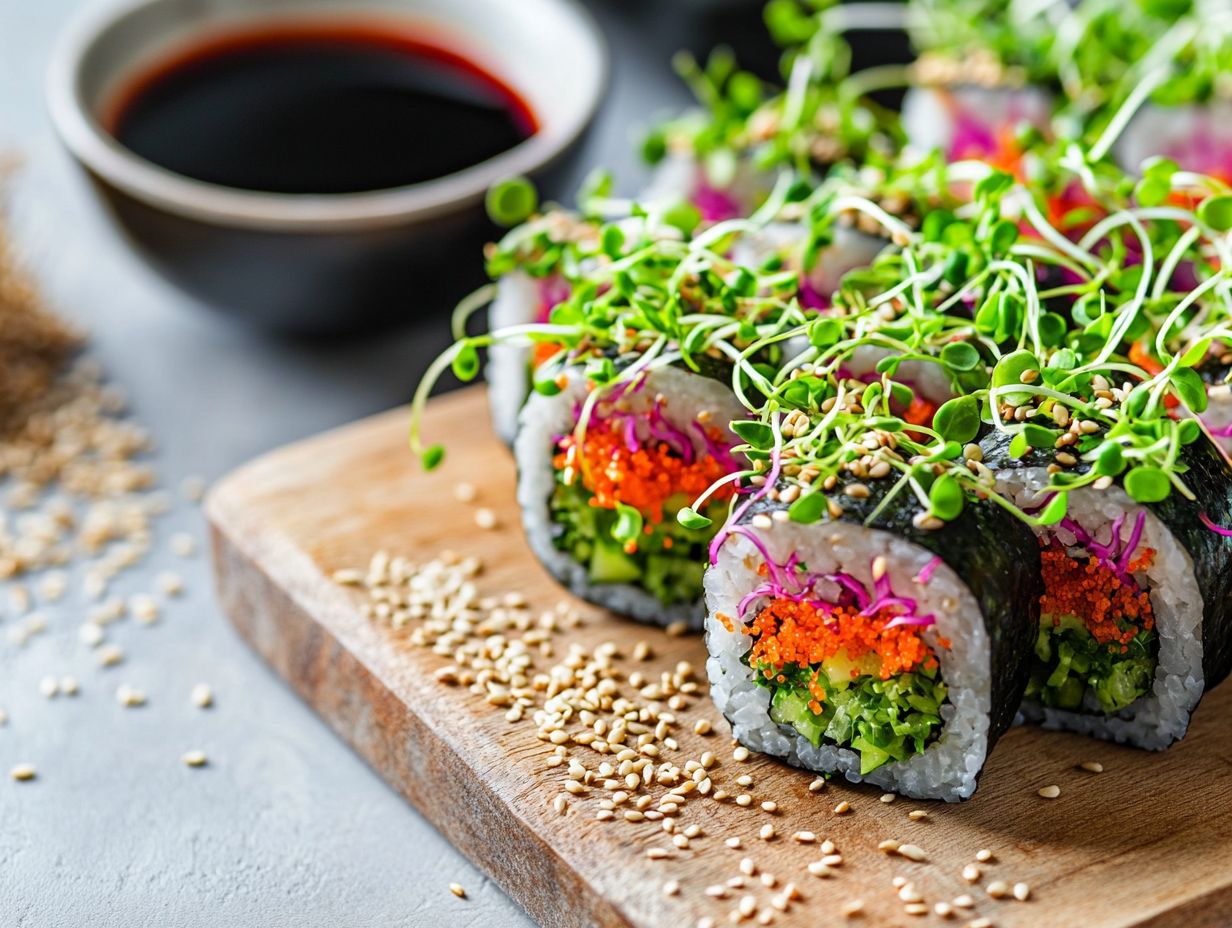
Growing your own microgreens is both exciting and easy! This means you can enjoy fresh greens at home with ease.
This step-by-step guide will lead you through the uncomplicated process, from selecting the perfect seeds to harvesting your nutrient-packed greens, ensuring you can seamlessly incorporate them into dishes like Korean rice bowls.
Step-by-Step Guide
A step-by-step guide to growing microgreens empowers you to select seeds and experience the delight of harvesting your fresh, flavorful greens at home. By following these gardening tips, you can cultivate a variety of nutrient-rich microgreens that help you eat healthier with tasty salads and filling stir-fries.
Understanding the essentials of microgreens is crucial; they thrive in various environments, making them suitable for both balconies and kitchens, offering a delightful way to enjoy fresh greens at home. Start by choosing high-quality seeds like arugula, kale, or radish, which deliver distinct flavors and are brimming with health benefits. You can also explore microgreen varieties in different cuisines to enhance your culinary experience.
Next, think about your growing medium; opting for organic potting soil or a seed-starting mix can significantly impact your success. Don t overlook the importance of light microgreens thrive with abundant natural sunlight or grow lights for at least 12 hours a day.
Watering techniques are just as vital; keep the soil consistently moist without crossing into sogginess to prevent mold. Be proactive about troubleshooting common issues like damping-off a fungal disease that can kill seedlings and pests, which are insects that can harm your plants. This will help ensure your greens reach their full potential, granting you the rewarding satisfaction of home-grown produce in no time.
Where to Buy Microgreens
Finding high-quality microgreens to elevate your meals has never been simpler, thanks to the myriad of purchasing options that cater to your unique preferences and needs.
Whether you prefer sourcing fresh ingredients from local markets, exploring specialty stores, or browsing online retailers, the abundance of microgreens available means you can effortlessly infuse your cooking with their vibrant flavors and exceptional health benefits.
Ready to bring fresh flavors to your kitchen? Start growing microgreens today!
Options for Purchasing Microgreens
You have many options for purchasing microgreens. Choose between local markets or online retailers to savor their vibrant flavors.
Shopping at farmers’ markets supports local growers and guarantees fresher produce. Grocery stores provide a consistent selection but may compromise freshness.
Online options let you enjoy the convenience of delivery to your home, though they might occasionally lack variety. By weighing these pros and cons, you can make an informed decision that aligns with your lifestyle, budget, and taste preferences, ultimately elevating your culinary experiences!
Frequently Asked Questions
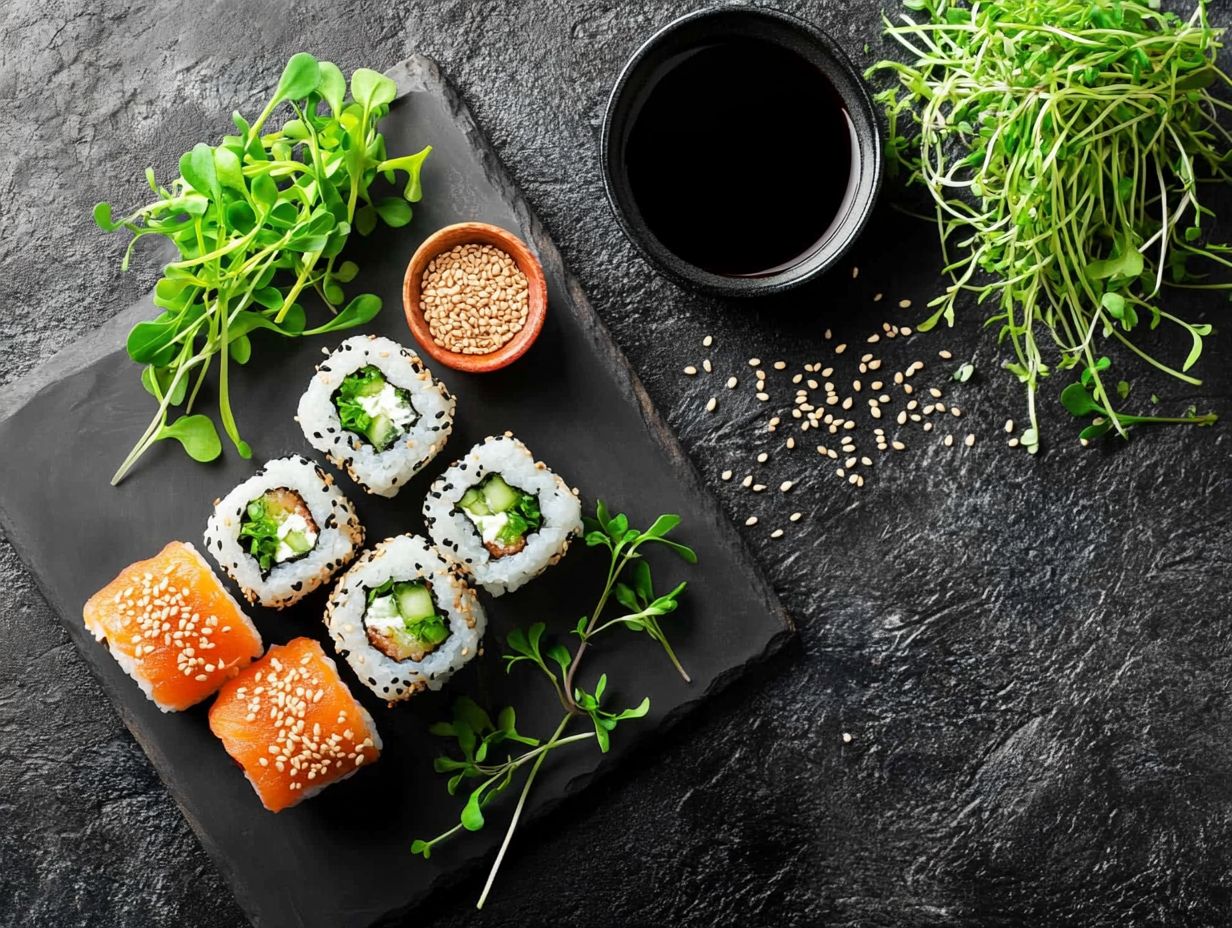
What are microgreens and how are they used in Asian cuisine?
Microgreens are small, young plants that are great for adding flavor to your meals. In Asian cuisine, they are often used as garnishes or added to dishes for extra texture and flavor.
What are some popular types of microgreens used in Asian cuisine?
Some popular types of microgreens used in Asian cuisine include:
- Cilantro
- Mustard greens
- Radish
- Watercress
How can I incorporate microgreens into my Asian dishes?
Microgreens can be used in various ways, such as:
- In salads
- Stir-fries
- Soups
- As toppings for sushi or noodles
They can also be used as a base for sauces or dips!
Are there any health benefits to using microgreens in Asian cuisine?
Yes! Microgreens are packed with nutrients, including vitamins, minerals, and antioxidants. They can also add a burst of flavor and texture to any dish.
Where can I purchase microgreens for my Asian recipes?
Excited to try microgreens? You can find them at most grocery stores or farmers’ markets! You can also grow them at home using microgreen growing kits or by purchasing seeds and growing them in a pot or tray.
Can I substitute microgreens for other herbs or greens in my Asian dishes?
Yes, microgreens can be substituted for other herbs or greens in most Asian dishes. However, keep in mind that their flavor and texture may differ from the original ingredient.

